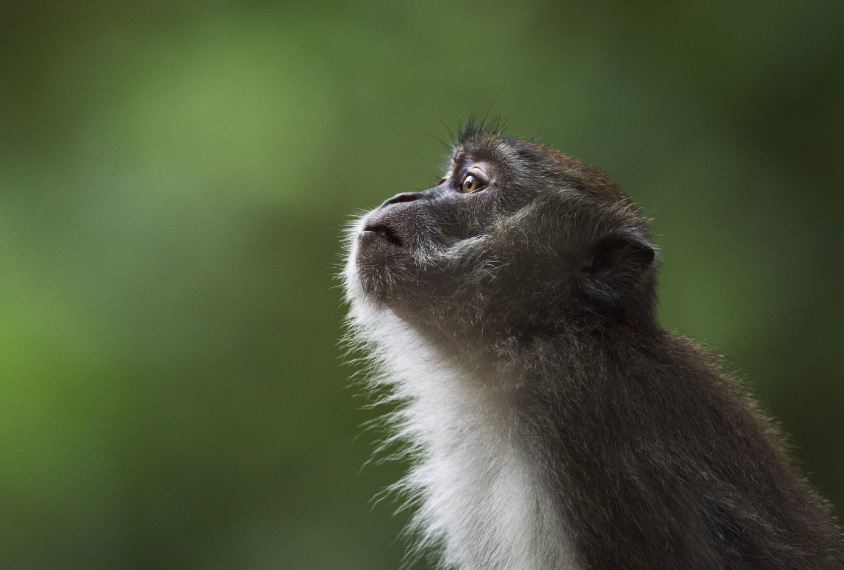
Monkey model reveals new role for top autism gene
Monkeys missing the gene SHANK3 have too few neurons in the prefrontal cortex, a brain region involved in planning and social behavior.
Monkeys missing SHANK3, a top autism gene, have too few neurons in the prefrontal cortex, a brain region involved in planning and social behavior, suggests a new study1. The work points to a previously unknown — and crucial — role for the gene in neurogenesis, the process by which neurons are formed.
Mice missing SHANK3 do not show the defect, so the study also reinforces the idea that monkeys are better suited for studying mutations related to autism.
“The monkeys seem to have more prominent molecular and cellular changes compared with mice,” says lead researcher Yong Q. Zhang, professor of genetics and developmental biology at the Chinese Academy of Sciences in Beijing. “It shows the value of pursuing non-human primate models further.”
Roughly 1 percent of people with autism have a harmful mutation in one copy of the gene or lack that copy altogether. Researchers have made a number of mouse models to better understand the effect of these mutations in the brain, but the mice’s behaviors have been inconsistent and do not match those seen in people with similar mutations.
SHANK3’s best-known function is at the junctions between neurons, or synapses, where it anchors other proteins in place. In typical newborn monkeys, the gene is primarily expressed in the prefrontal cortex. In mice, by contrast, SHANK3 is expressed at its highest levels in the striatum, a brain region that governs movement and reward.
“SHANK3 may play a very different role in the primate brain than in the rodent brain, making monkeys a better model for people,” says Michael Platt, professor of psychology at the University of Pennsylvania in Philadelphia, who was not involved in the study.
The new findings are based on three cynomolgus monkeys, also called crab-eating macaques. Two of the monkeys died shortly before or at birth, but postmortem analyses of their brains revealed an unusual distribution of cells: Both monkeys had an unusually small number of neurons and a large number of non-neuronal cells, called astrocytes, in the prefrontal cortex.
The results appeared 25 July in Cell Research.
Making monkeys:
To make the monkeys, the researchers turned to the gene-editing tool CRISPR. (Another team at the Massachusetts Institute of Technology is working on a similar project.)
Zhang’s team used CRISPR to delete SHANK3 in single-cell monkey embryos. They transferred 116 embryos to 37 surrogate mothers. This yielded only three pregnancies.
The low pregnancy rate is “very surprising,” says Karen Parker, associate professor of psychiatry and behavioral sciences at Stanford University, who was not involved in the work. It’s possible CRISPR introduces unintended mutations that make the embryos unviable, she says.
Alternatively, the low rate might reflect SHANK3’s importance in early development.
For unknown reasons, some cells in the developing embryo express normal levels of the gene. The monkey that died before birth lacked the gene in the prefrontal cortex but expressed a short version of the protein in the striatum; the one that died at birth had more cells with normal levels of the gene.
The surviving monkey may have had the greatest amount of functional SHANK3 protein, Zhang says. His team plans to scan the monkey’s brain as it matures to examine how SHANK3 mutations affect brain size.
Monkey see:
The most severely affected monkey had low levels of certain proteins at synapses in the prefrontal cortex — perhaps because these proteins need SHANK3 to lock them at the junction. The proteins include mGluR5, GluN2B and PSD95, all of which are associated with autism.
It is unclear how SHANK3 might influence neurogenesis, says Yong-Hui Jiang, associate professor of pediatrics at Duke University in Durham, North Carolina. “This suggests some additional novel function for SHANK3 in addition to classical synaptic functions,” he says.
The surviving monkey is showing some atypical behaviors and can easily be distinguished from control animals of the same age, Jiang says. Rigorous testing of the monkey’s social behavior may help the researchers better understand the effect of SHANK3 mutations.
Monkeys, like people, rely on vision during social interactions. “Both species produce facial expressions and both species make eye contact,” says Katalin Gothard, professor of physiology and neuroscience at the University of Arizona in Tucson, who was not involved in the study. Mice, by contrast, rely on their sense of smell. “These behaviors are not testable in mice,” Gothard says.
Platt studies a large feral colony of monkeys on Cayo Santiago, an island off Puerto Rico. A few monkeys on the island have natural variants in SHANK3 and behave unusually in the island’s social groups. “We will all be waiting for news on the behavior of the third CRISPR SHANK3 mutant monkey,” Platt says.
References:
- Zhao H. et al. Cell Res. Epub ahead of print (2017) PubMed
Recommended reading

New organoid atlas unveils four neurodevelopmental signatures
Explore more from The Transmitter

The Transmitter’s most-read neuroscience book excerpts of 2025

Neuroscience’s leaders, legacies and rising stars of 2025


